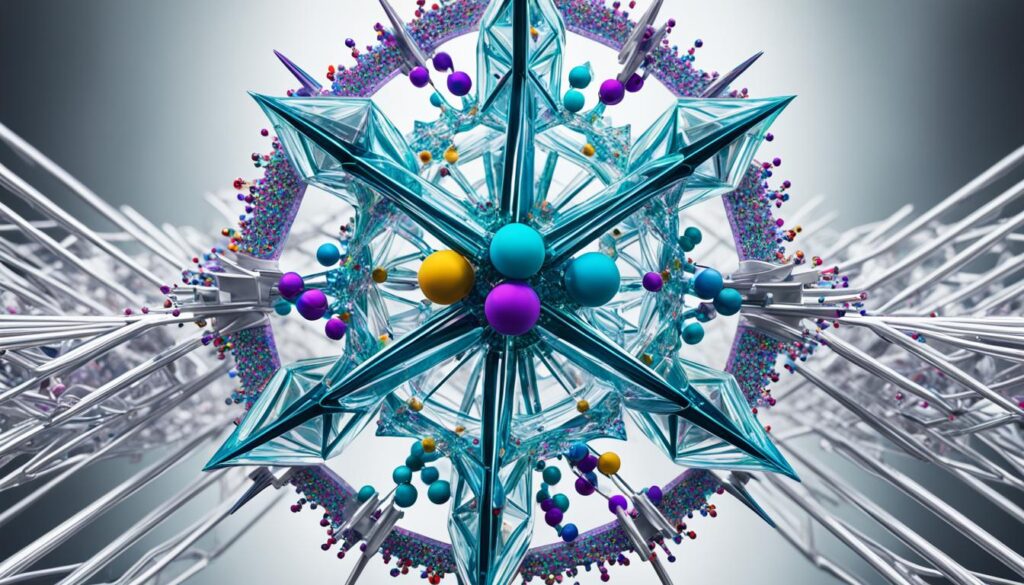RIKEN and the IBM Q Network are working together on a fascinating project. They are looking into 2D discrete time quasicrystals (DTQCs) using the IBM Quantum Heron. This project is a huge step for quantum computing. It helps us understand the kicked Ising model better. It also points the way to new discoveries in quantum physics.
Unveiling Prethermal States in Quantum Physics
Quantum physics has made a big find: the prethermal regime in Floquet systems. This discovery is changing how we see quantum many-body systems. Scientists at RIKEN used the IBM Quantum Heron processor to study the Ising model. Their work sheds light on states of matter before they reach thermal equilibrium in these systems.
Prethermalization lets us look into systems that stay non-equilibrium for a long time. In this phase, quantum systems show new behaviors like oscillating magnetization. Before, it was thought these would quickly become high-entropy thermal states. This could change how we view the stability and lifespan of quantum states, helping quantum computing and info processing.
RIKEN found a period-doubling time crystal behavior, linking the Ising model to quantum tech progress. Their research highlights oscillations unique to the prethermal stage. Here, systems don’t quickly become thermalized. This shows some many-body states can resist moving toward equilibrium longer than expected.
This deep dive into quantum states opens new research paths and asks big questions about computational limits. Exploring how Floquet systems respond to outside forces shows the prethermal regime is key. It brings together quantum physics principles with the actions of quantum many-body systems.
RIKEN’s Computational Quantum Matter Research Collaboration
The RIKEN Center for Emergent Matter Science leads in groundbreaking research. It forms a research collaboration with experts in computational quantum matter. The teams, including the Computational Quantum Matter and Quantum Computational Science teams, work together. They aim to advance quantum computational science.
RIKEN has made strides in studying prethermal regimes through this teamwork. They used the IBM Quantum Heron for research. Their work has shed light on the behaviors of two-dimensional discrete time crystals. This is a key achievement in computational quantum science.
The Computational Materials Science and Computational Condensed Matter Physics teams have also contributed greatly. They’ve helped understand quantum systems’ complex interactions. Their work underlines the power of collaborative research at RIKEN.

The collective effort at the RIKEN Center for Emergent Matter Science stands out. It shows how research collaboration moves the field forward. This blend of theory and practice leads to significant discoveries in computational quantum matter. It opens doors to exploring quantum macroscopic phenomena.
Quantum Hardware Development: The Role of Superconducting Qubits
Quantum technology is growing fast, and reliable hardware is key. Superconducting qubits are at the heart of this. They’re what quantum processors like the IBM Quantum Heron are made of. These qubits stay coherent for a long time. This lets us handle quantum states and run complex quantum algorithms.
The IBM Quantum Heron is a big step forward in quantum hardware. It has 133 superconducting qubits in a special layout. This setup lets us simulate complex quantum behaviors. The stable qubits are great for studying time-crystals and systems not in balance.
Superconducting qubits help make quantum tech more precise. They let us explore new kinds of matter and understand quantum states better. With these qubits, researchers can study the Floquet Hamiltonian space in detail. This means we can explore more quantum phenomena.

Superconducting qubits are very important. They’re not just parts of quantum circuits. They drive innovation in quantum hardware. The work between research places like RIKEN and tech like IBM Quantum Heron is pushing quantum tech forward. This is thanks to the detailed work on superconducting qubits.
Advancing Quantum Many-Body System Simulations with RIKEN IBM Quantum Heron
RIKEN is on a quest with IBM Quantum Heron to explore quantum many-body systems. They’re breaking new ground in the world of digital quantum computing. This work shines a light on complex quantum secrets that are hard for normal computers to figure out. The kicked Ising model is where they’re seeing exciting discoveries, like signs of unknown states of matter.

The team blends digital skills with deep theory to look closely at local magnetization. Their careful work matches up with sophisticated simulations. This shows that the data they gather is right on target. It also proves how well IBM Quantum Heron can catch and study the fine details of quantum interactions.
The power of the 133-qubit system and doing up to 100 time steps is changing the game. It’s moving past the limits of old-style simulations. IBM Quantum Heron is showing its value in the hunt for knowledge about quantum systems. RIKEN’s recent work shows just how much quantum computing can do. It’s speeding up our journey into the quantum universe.
Assessing the Stability of Quantum Discrete Time Crystals (DTCs)
Scientists are diving deep into the world of quantum discrete time crystals (DTCs). They are looking hard to find how stable they are. The RIKEN team did experiments and found out how these crystals can last.
They saw that these crystals can keep their rhythm even when things change around them. This shows they might be able to make perfect time crystals in 2D quantum systems.

The RIKEN team didn’t just learn about how tough these crystals are. They also found a special type called prethermal DTCs. These can last even longer and work closer to normal conditions.
This info helps us understand more about DTCs and new kinds called discrete time quasicrystals (DTQCs). It’s like unlocking secrets of how these quantum systems work.
These discoveries show how good quantum crystals are at keeping their cool. It also hints at new stuff we can do with quantum technology. This could lead to making new materials and using the strange ways of time crystals.
Challenges of Classical Simulations and the Breakthrough with IBM Q Network
Quantum systems are very hard to understand. Classic computer ways often can’t handle their complexity. Issues like thermalization challenge these simulations. But, the IBM Q Network with RIKEN has made big steps forward. They use quantum computing to move past these old limits.
RIKEN used IBM’s Quantum Heron processor. This is part of the IBM Q Network. They tried new ways to fix errors in quantum simulations. Their work helped make these simulations more accurate. It also let us see quantum dynamics in a new way. Their efforts show how we can go beyond old limits with simulations.
RIKEN and IBM Q Network together are changing how we study quantum physics. They turned error fixing from a problem into a chance for better studies. They have looked into quantum states more carefully than ever before. Their work speeds up how fast we learn about quantum science. It helps us understand and simulate its complexities better.
